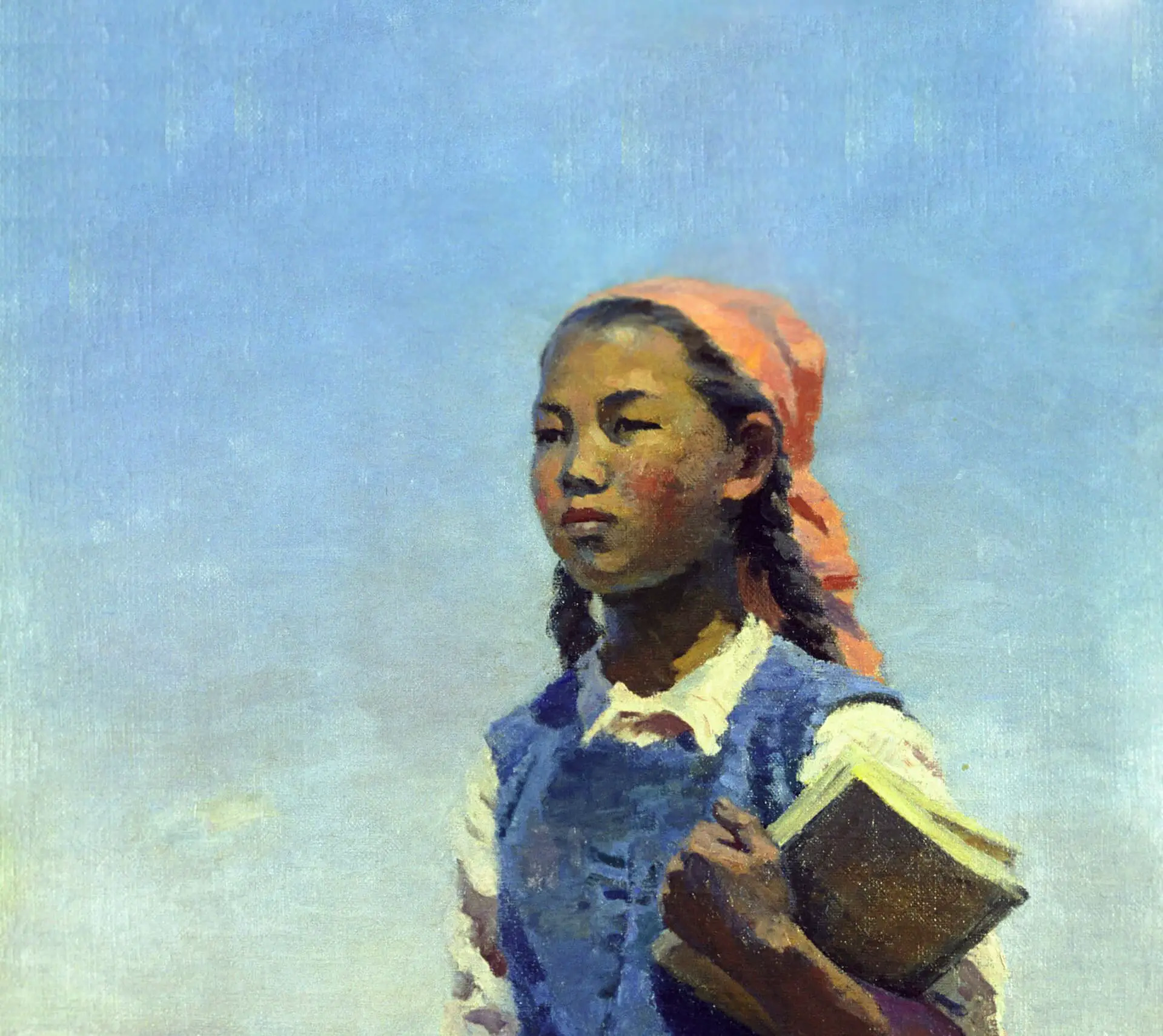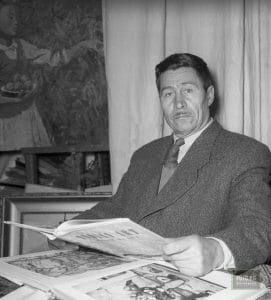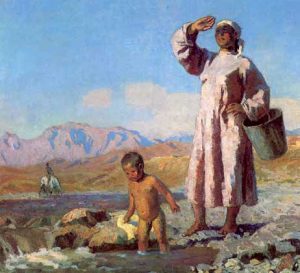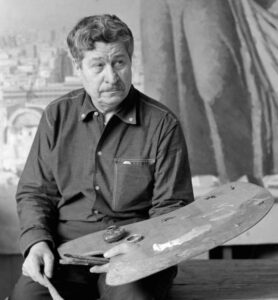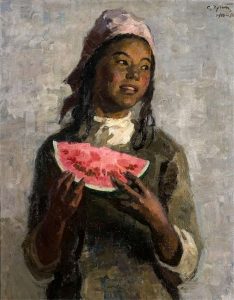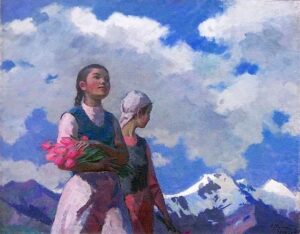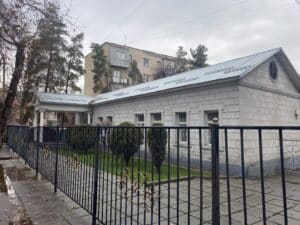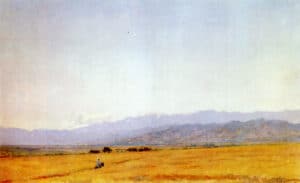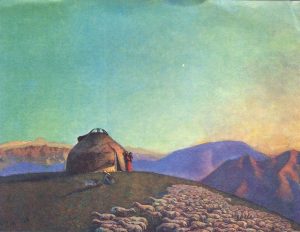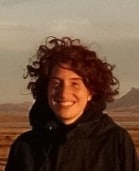The Faces of Kyrgyzstan is a project of the popular Russian-language website Limon.kg based in Kyrgyzstan. The project presents those natives of Kyrgyzstan which have helped form the current country and especially its modern culture. The profiles are presented on Limon.kg in Russian. Translation was performed by Sophia Rehm, a SRAS Home and Abroad Scholar studying in Bishkek.
Semyon Afanasevich Chuikov is a name associated with the most outstanding achievements in Kyrgyz painting. It was thanks to Chuikov that the first art gallery was established in the Kyrgyz Republic, and the first exhibitions of Kyrgyz artists were organized.
Semyon Chuikov’s Childhood
Semyon Afanasevich was born on October 30, 1902, in the city of Bishkek (then known as “Pishpek”). His parents were Russian immigrants from the peasant class. His father, Afanasy Chuikov, served as a clerk in a military hospital, and his mother, Evdokia Georgievna, worked in the same hospital as a laundress. His childhood was difficult, and spent in extreme poverty. Left to himself, Chuikov often disappeared for days, sometimes going off with Kyrgyz boys into the mountains, where, in poor, smoky yurts, he listened to Kyrgyz folk songs with pleasure. His sense of beauty came into being under the influence of the nature surrounding him: vast steppes, majestic mountain landscapes, and the noise of fast mountain rivers.
At 10 years old, Chuikov was first introduced to art, under the guidance of the artist N.G. Khludov, an elementary school art teacher. In 1920, Chuikov entered the Turkestan art school in Tashkent, where he first encountered the culture of a big city, with its art museum, opera house, and conservatory. In art school, he made lifelong friends, and grew close with M.V. Kuprianov, and with E.A. Malevina, who would soon become his wife. In 1927, Chuikov first participated in the All-Union art exhibit “Art of the Peoples’ of the USSR,” as an artist of Kyrgyzstan. During the 1930s, Chuikov was involved in numerous organizational activities. He created an art museum, for which he managed to acquire dozens of works by famous Russian and Soviet artists. In 1934, the Artists’ Union of Kyrgyzstan was organized with Chuikov’s active assistance. In 1935, an art studio was opened that would be the basis of the art school, established in 1939, that today bears Chuikov’s name.
By this time, Chuikov had demonstrated extraordinary talent and fine aesthetic sensitivity, creating landscapes and portraits that employed the bright colors native to his homeland. Chuikov first gained fame for The Kyrgyz Kolkhoz Suite, a cycle whose best images, despite the Soviet epithet “kolkhoz,” poeticize traditional, “eternal” characteristics of the nature and life of his rural land. Even the last painting in the cycle, The Daughter of Soviet Kirghizia, which Soviet mass media practically turned into a propaganda poster about the triumph of socialism in Central Asia, is really just a bright and fresh study of a village schoolgirl against a backdrop of distant mountains. The girl’s figure expressively and succinctly symbolizes not socialism, but Kirghizia itself.
The Post-War Period and Chuikov’s Golden Period
The post-war period witnessed Chuikov’s most successful period as an artist. Several of his paintings achieved enormous popularity such as: Morning, Noon, Evening, and The Daughter of Soviet Kirghizia. The Chuikov House Museum’s exhibition consists of extensive material covering a 60-year period of the artist’s career and the development of Kyrgyz visual arts. Among items on display are paintings, sketches, photographs, documents, letters, and personal items donated by relatives. The main hall of the exhibition is the artist’s studio. In the center is a work area, with a handmade table, on which lie a pallet and paint brushes. On an easel is the artist’s first sketch for the painting The Daughter of Soviet Kirghizia, made with charcoal. At the Brussels World’s Fair in 1958, two of Chuikov’s paintings – The Daughter of Soviet Kirgizia and Shephard’s Daughter – were awarded the Gold Medal.
Over the years, Chuikov’s colorism and mastery of shaping images in bright colors – akin to the earlier style of the artists in the Russian avant-garde group Jack of Diamonds – were only further enriched. The impressions left by two trips to India played a particularly significant role. He published three books of travel essays and memoirs: Images of India, Notes of the Artist, and Italian Diary (Образы Индии, Заметки художника, Итальянский дневник). In the 1950s and 1960s Chuikov traveled widely: to India, Italy, France, Greece, and Bulgaria. From these trips, he brought back to his homeland a wealth of material in the form of a variety of studies, pencil sketches, and, in his artist’s memory, a complete, living sense of distinctive aspects of life. Chuikov’s interesting Indian series is an organic continuation of his Kyrgyz theme. It conveys, with impressive honesty, the life of simple people, creating a picture of the character of a people. Through Chuikov’s paintings we visually grasp qualities of our world, and the human need for happiness, and for a harmonious existence, light, and joy. For the series From the Life of the People of India, Chuikov was the first Soviet artist, in 1967, to be awarded the Jawaharlal Nehru Award. Two works from this series are displayed in the House Museum: Waiting, and Newlyweds from the Untouchable Caste. In these works, the artist managed to convey the inner world of the characters. In 1963, Chuikov made a fascinating journey to Italy. He painted Lake Albano and the Appian Way, depicting nature resembling that of Kyrgyzstan. In 1966, the artist published his Italian Diary, full of interesting observations and lively sketches.
The Death and Legacy of Semyon Afanasevich Chuikov
Semyon Afanasevich Chuikov’s legacy is enormous. His works have entered the permanent collections of many major museums, such as the State Tretyakov Gallery in Moscow, the State Museum of Oriental Art in Moscow, The Museum of Fine Arts of Kyrgyzstan, various museums of India, the Dresden Gallery, and others. In his paintings, genre and landscape painting come together in a single work.
Chuikov paid great attention to the education of his assistants, worked to open an art school, and helped art students who had studied in Moscow and Leningrad. Some of these later became famous artists, like G. Aytiev, S. Akylbekov, D. Kozhakhmetov, A. Usubaliev, and S Chokmorov.
Chuikov died in Moscow on May 18, 1980.
The House Museum of Semyon Chuikov
The following review of Semyon Chuikov’s house museum was written by Stephen Foley, an SRAS student studying in Bishkek.
The House Museum of Semyon Chuikov is the former home of celebrated Kyrgyz painter Semyon Chuikov, who is considered one of the founders of modern Kyrgyz painting. The small three-room museum hosts some of his most famous works and preliminary sketches, such as that for “Daughter of Soviet Kyrgyzstan.” Beyond art, the home contains such memorabilia as personal belongings, brushes, and other equipment he used to create his art. Offering free entrance to all, this small museum is a highly recommended site to visit during your time in Bishkek.
The museum is located just under 1.5 km southeast of Ala-Too Square near the center of Bishkek, at Chuikova 87a. It is halfway between the London School of Languages, where SRAS programs are based in Bishkek, and the city center. The museum is tucked away in a quiet part of town and can be easily missed unless looking for it.
The house, constructed from stone and painted white with a metal roof, stands out from the neighboring structures. The home and its courtyard are surrounded with a black metal gate and were once shared by Chuikov and his wife and fellow artist, Yevgeny Maleina from 1949-1979. The museum was founded there in 1987, on the eve of the 85th anniversary of the artist’s birth and seven years after the passing of the late Chuikov. It is now funded through different departments belonging to the local and regional governments.
When entering the museum, you will be greeted by a peculiar set of doors. In fact there are two sets of front doors, one behind the other, that makes entering the museum a little awkward your first time, especially if you were not expecting to be greeted with another set of doors immediately after opening the first set. These are not uncommon in Soviet construction, however, as they help maintain the temperature inside a structure.
Once inside, there will be at least one person working behind a small administrative desk that will welcome you. Unfortunately, there are no audio guides or paper guides available, and the staff only speak Russian and Kyrgyz. Moreover, most of the exhibits are only labeled in Russian and Kyrgyz, which can make reading them challenging for an American student of those languages. However, since there are so many photos, newspaper clippings, and other contextual displays it is very easy to follow along with the life of the artist as you make your way through the museum even if the language is challenging.
The museum building is extremely well kept. The orderly displays line the walls in a neat and linear fashion displaying only the works and artifacts deemed to be important enough to make the cut to concisely tell the story of the great artist’s life. The nearby Gapar Aitiev Memorial Museum, in comparison, has works of art in every free space and piled up against the walls in some areas.
While walking through the entire museum will take less than 30 minutes, many of the works that lie within are stunning. The museum’s walls feature paintings and sketches like: Boy with Corn, Girl in a Scarf, Bathing Boys, Outskirts of Bukhara, Akyn among the Poor, and Wildflowers. These works are marked by intense emotion, purity, and harmony, affirming the idea of human dignity.
The first room of the museum is the smallest and contains a few pieces of art and a few memorial plaques. One of the large metal plaques hanging upon the wall contains the face of Chuikov as well as the dates of his birth and death. There is another smaller plaque with the dates to commemorate the founding of the museum. Interestly, there is also a plaque to the Hungarian sculptor Daslo Mesaros, who lived in the same house from 1937 to 1938. Lastly, there is a small glass display case with photos of Chuikov during his life, which included working as a teacher and later as a founder and chairman of the board for the Union of Artists of the Kyrgyz SSR.
The second room of the museum is the largest and has paintings along three walls and a glass display case against the fourth. The paintings in this room are mainly focused on portrait and landscape paintings. The room showcases some of Chuikov’s pieces inspired from his time in India which stand out from the color and shading used. The paintings in this room are well spaced from one another and give you an opportunity to really admire the works individually as you make your way through. Furthermore, the glass display case shows photos and newspaper clippings of Chuikov receiving the state awards earned during his lifetime such as his two State Prizes of the USSR, the I. Satylganov State Prize of the Kyrgyz SSR, as well as the Order of Lenin, the Toktogul Prize, and the Jawaharlal Nehru Award for International Understanding. Lastly, there are letters and journal entries he wrote displayed. The documents are so well maintained, you can still make out much of the writing.
The third room is slightly smaller than the second room but feels much more packed. Two glass display cases line the walls facing one another and Chuikov’s desk and a small sculpture take up the space against the wall across from a set of large windows. Within one of the glass display cases are a few preliminary sketches from some of his now-famous paintings as well as different sets of brushes he used in his work. Another display case again shows different photos of Chuikov receiving awards and meeting with Kyrgyz and Soviet leaders. The desk portion of the room is partitioned off so that visitors don’t step on old and worn original rug that lies on the floor with it.
The museum gives you a strong sense of the impact Chuikov had on Kyrgyz art. While the museum is quite old, the employees maintain it very well and this gives it a unique atmosphere that feels almost like a modern art gallery in an old home. The material within the museum offers you a look into the life and achievements of Chuikov.
The museum offers free tours, but only in Russian or Kyrgyz. Don’t let that stop you from asking questions or starting conversation. The employees are extremely insightful about the life of the artist and are extremely inviting and welcoming especially if you show interest. While they do not allow photos of the inside of the museum, if you ask they will show a short film about the life of the artists in the second room. Moreover, the museum hosts many significant events, from panel discussions, memorial evenings, temporary exhibitions, and even the occasional master class. You can find out about upcoming events by calling the museum or stopping in and asking an employee.
The museum is open Monday through Friday 9a.m.-5p.m., with an hour-long lunch break from noon to one.
The House Museum of Semyon Chuikov is a nice place to visit to learn more about the artistic culture of Kyrgyzstan. As a way to make a whole day’s experience you could visit the Chuikov museum, the Gapar Aitiev Memorial Museum, the Iskhak Razzakov Memorial Museum, and even a walk by the Kyrgyz State Art school named after Semyon Chuikov because they are all located in the same neighborhood. Visiting these museums would be a great way to truly get to know about the history and artists who inspired the current generation of Kyrgyz. All the museums are small and won’t take much time to visit but each has a very unique atmosphere including representations of what life was like for the artists in the 20th century and many of their works that you won’t find anywhere else.


